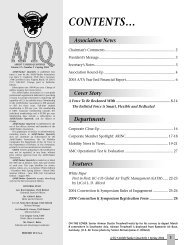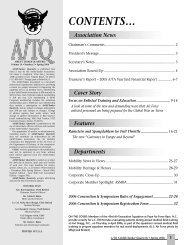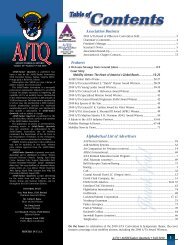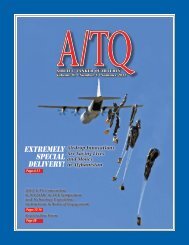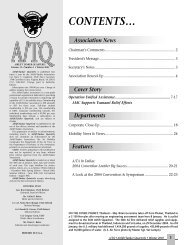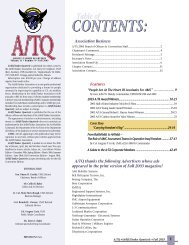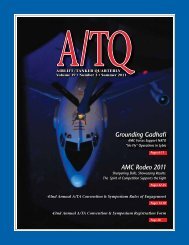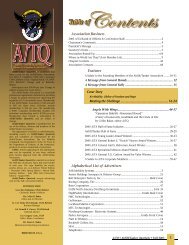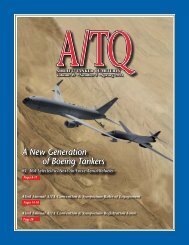A Salute to the A/TA Industry Partners - Airlift/Tanker Association
A Salute to the A/TA Industry Partners - Airlift/Tanker Association
A Salute to the A/TA Industry Partners - Airlift/Tanker Association
Create successful ePaper yourself
Turn your PDF publications into a flip-book with our unique Google optimized e-Paper software.
The <strong>Airlift</strong>/<strong>Tanker</strong> <strong>Association</strong> Specialized Mission Award is presented annually<strong>to</strong> an outstanding individual whose performance of duties in support of anaerial air mobility mission is exceptionally noteworthy during crises,contingencies, or humanitarian airlift. This award is presented<strong>to</strong> career fields not covered by <strong>the</strong> Huyser Award categories.2011 A/<strong>TA</strong>Specialized Mission AwardMajor John F. Baer is <strong>the</strong> Assistant Direc<strong>to</strong>r Operations/AeromedicalEvacuation Planner, 21st Air Mobility Operations Squadron,Joint Base McGuire-Dix-Lakehurst. He holds a Bachelor of Sciencein Nursing Science, University of Texas, San An<strong>to</strong>nio, TX (1999),and a Master of Emergency/Disaster Management, Touro UniversityInternational, Vallejo, CA (2008).Major Baer volunteered for a 365-day deployment<strong>to</strong> Kandahar Air Base as an Air Advisor <strong>to</strong><strong>the</strong> Afghan Air Force from January <strong>to</strong> December2010. He worked for <strong>the</strong> NATO Air TrainingCommand-Afghanistan and was responsible foradvising <strong>the</strong> Afghan Air Force on establishinga sustainable Aeromedical Evacuation system.Through a year of men<strong>to</strong>ring, classroom instructionand hands-on experience, Baer and his teamworked <strong>to</strong> improve <strong>the</strong> level of aeromedical andcasualty evacuation care provided by <strong>the</strong> AfghanAir Force. Modern battlefield medicine relies on anetwork of battlefield aid stations, regional medicalcenters and rehabilitative hospitals linked byan air evacuation system that quickly and safelymoves patients up <strong>the</strong> chain.For a wounded soldier in <strong>the</strong> Afghan National Security Forces,MEDEVAC was often provided by a Coalition Force aircraft and crew,not by his fellow Afghans. Baer’s small team of American medicalmen<strong>to</strong>rs and <strong>the</strong>ir coalition partners worked “shoulder <strong>to</strong> shoulder”with <strong>the</strong>ir Afghan medical counterparts <strong>to</strong> teach <strong>the</strong>se necessaryskills and build <strong>the</strong> capacity for <strong>the</strong>m <strong>to</strong> care for <strong>the</strong>ir own in combat.In September 2010, wounded Afghans began <strong>to</strong> be evacuated <strong>to</strong>higher levels of care on regularly scheduled AAF transports and helicoptersunder <strong>the</strong> care of Afghan aeromedical technicians trained byBaer and his team.“When we first arrived at Kandahar, <strong>the</strong> air evacuation systemwas very basic,” said Baer. “The regional hospital would just deliverpatients <strong>to</strong> <strong>the</strong> next available flight <strong>to</strong> Kabul without preparation orprior coordination and simply put <strong>the</strong>m on <strong>the</strong> floor. Once <strong>the</strong> plane<strong>to</strong>ok off, <strong>the</strong>re weren’t any flight medics on board <strong>to</strong> provide care.”Baer helped set up a training program <strong>to</strong> teach a small core of AAFaerial medics how <strong>to</strong> stabilize patients for flight and secure <strong>the</strong>msafely on <strong>the</strong> aircraft <strong>to</strong> prevent fur<strong>the</strong>r injury. They also taught<strong>the</strong>m <strong>the</strong> special skills needed <strong>to</strong> care for wounded soldiers in <strong>the</strong> air.“We would spend two days a week in <strong>the</strong> classroom teaching aeromedicalcare through repetition and hands-on practice,” he said. “Inaddition <strong>to</strong> patient prep and in-flight care, we provided instructionMajor John F. Baer“…any citizen should be willing <strong>to</strong> give all that he has <strong>to</strong> give hiscountry in work or sacrifice in times of crises.”–Eleanor Rooseveltwith advanced equipment <strong>to</strong> care for more seriously injured soldiers.They picked up <strong>the</strong> technology with enthusiasm, despite a few languageand literacy barriers.”He spent a great deal of time in <strong>the</strong> air alongside <strong>the</strong> Afghan medicson AAF flights.“I flew alongside Afghan medics on 55 missionsin <strong>the</strong>ir MI-17s as we put our classroom work in<strong>to</strong><strong>the</strong> lives of wounded Afghans,” said <strong>the</strong> major.“These were challenging missions and <strong>the</strong>y madea real difference, I saw <strong>the</strong>m save lives.”The men<strong>to</strong>r team also worked with <strong>the</strong> ANSFhospital system, AAF and <strong>the</strong> Afghan medical coordinationcenter <strong>to</strong> address <strong>the</strong> random and unscheduledapproach <strong>to</strong> aeromedical evacuation.The key was having <strong>the</strong> hospitals know when <strong>the</strong>yneeded <strong>to</strong> move patients <strong>to</strong> aircraft dedicated <strong>to</strong>MEDEVAC missions, and also in having trainedmedics ready <strong>to</strong> fly on <strong>the</strong>m.The AAF’s Kabul and Kandahar Air Wings createdweekly flights from <strong>the</strong> Kandahar RegionalMedical Center <strong>to</strong> <strong>the</strong> National Military Hospital inKabul. The regular missions schedule time for <strong>the</strong>KRMC <strong>to</strong> prepare wounded Afghans for transport and <strong>to</strong> prioritizecare for <strong>the</strong> most critical cases.Considering <strong>the</strong> conditions at <strong>the</strong> beginning of his <strong>to</strong>ur, Baer wasvery impressed with <strong>the</strong> changes.“In less than ten months, ANSF aeromedical care evolved frombasically ‘a plane is here, place him on <strong>the</strong> floor’ <strong>to</strong> Afghanscoordinating and scheduling <strong>the</strong>ir own medical evacuation missions.They are also preparing, securing and caring for <strong>the</strong>irwounded countrymen in flight,” said Baer. “I’m very proud <strong>to</strong>have been working alongside <strong>the</strong> Afghans during <strong>the</strong> start of thiscritical capability.”While deployed, Major Baer networked with his local communitysoliciting over 500 pounds of children’s clothing given <strong>to</strong>Christian Ministries Center on Kandahar Airfield for distribution<strong>to</strong> Kandahar City school children. He also supported a CanadianArmy Fun Run completing a 4 mile run. The proceeds from <strong>the</strong> runexceeded $11,000 and were donated <strong>to</strong> local Kandahar schools.Major Baer’s achievements include receiving <strong>the</strong> Verne Orr Award,621st Contingency Response Wing (2007, 2008, 2009 and 2010); <strong>the</strong>Emergency Nurse Excellence Award (1999); AMC Flight Nurse of Year(2003); and <strong>the</strong>Lillian Kiel Award, AMC (2008). 438th Air ExpeditionaryWing Field Grade Officer of <strong>the</strong> Quarter (2010).A/TQ • <strong>Airlift</strong>/<strong>Tanker</strong> Quarterly • Fall 201147



